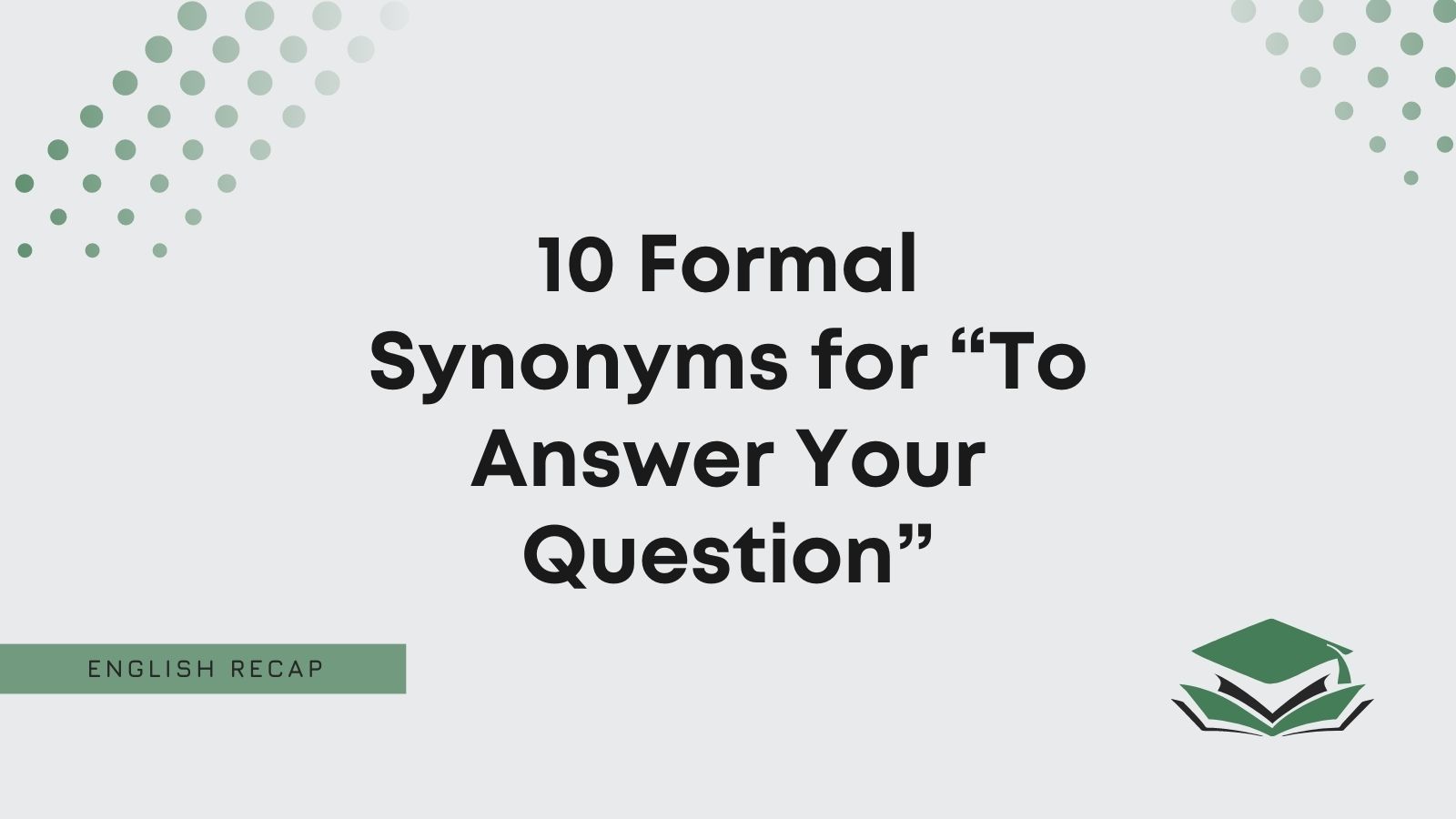You should know how to politely answer a question when someone poses one. However, is “to answer your question” the best formal phrase?
Well, you’re already asking yourself that question. So, it’s best to let us explain it to you and provide you with some excellent synonyms.
Is It Formal to Say “To Answer Your Question”?
It is not formal to say “to answer your question.” Unfortunately, it is unprofessional in most contexts, making it useless if you include it in a business email.
With that said, it’s still a great phrase informally. We highly recommend using it to answer your friends’ questions when they need you to.
You can use it informally as follows:
To answer your question, yes! I do think you’re on to a winner.
Pros
- It’s a fun and friendly way to answer a question.
- It works well in most informal written contexts.
Cons
- It does not work well formally.
- It sounds quite rude if you use it in the wrong setting or tone.
“To answer your question” doesn’t work well formally. So, you’ll want to have an alternative ready to use when you need to sound formal and polite.
Keep reading to learn another way to say “to answer your question.” There are plenty of great formal synonyms available, after all.
What to Say Instead of “To Answer Your Question”
- In answer to your question
- I would like to give you an answer
- To give you an answer
- Yes/no
- My answer is
- If you need an answer now, then
- In response
- Back to your question
- I have an update
- You may want to know
1. In Answer to Your Question
“In answer to your question” is probably one of the best phrases to replace “to answer your question.”
It’s much more respectful and formal. Generally, it allows you to directly answer a question that someone has posed in a previous email.
For instance, let’s say a client has asked about a project. You can say “in answer to your question” in a follow-up email to let them know what to expect from the project’s progress. It’s a great way to get to the point quickly.
You may also refer to the following example:
Dear Adrian,
In answer to your question, no. We cannot continue with this project without outside funding.
All the best,
Sam Weiss
2. I Would Like to Give You an Answer
In a more friendly sense, you can say “I would like to give you an answer.”
It works well when you have a rough answer to give someone, but you might not have all the information yet.
We recommend using this when emailing employees. It shows that you’re happy to answer them, even if you only give them a basic answer. You could always improve upon your answer at a later stage when you have more information to share.
Here’s a great email example to help you if you’re still unsure:
Dear Mario,
I would like to give you an answer to your previous question. So, yes, we are more than happy to work with the new client.
Yours,
Juliet Simmonds
3. To Give You an Answer
Try using “to give you an answer” instead of “to answer your question” in formal emails. It works well because it is clear and direct.
You may use it when emailing customers. It shows that you want to answer a question they sent you directly.
This is helpful as it lays out your answer immediately. So, a customer can expect the answer early in the email to know what to expect from you.
Check out this email sample as well:
Dear Brian,
To give you an answer, I’m afraid we do not know. We are still looking into alternative methods, and we will provide you with more information soon.
Thank you so much,
Mr. Hower
4. Yes/No
The extra wording really isn’t necessary. You don’t have to say “to answer your question” or any of the synonyms at all. Instead, to keep things formal and polite, just provide the answer.
Of course, any answer is applicable in this situation. For simplicity’s sake, we’ve touched on “yes” and “no” (as they tend to be the most common answers).
These alternatives are direct and get to the point. You do not have to use extra fluff like “to answer your question.” So, we highly recommend using them in professional emails.
We recommend the following examples if you’re still unsure:
Dear Thomas,
No, I cannot help you with the situation any further. I’m so sorry about that.
All the best,
Julia Lodi
Hi Martin,
Yes, I am available to help when you need me. Thank you for coming to me.
Yours,
Bard Morris
5. My Answer Is
To make your answer more personal, you may want to start an email with “my answer is.”
Using the personal possessive pronoun “my” shows you have thought about the answer. It becomes more of an opinion than a fact.
So, we recommend using it when emailing an employee. It might work well if they asked about promotion. You can use it to provide a positive answer, letting them know you’ll consider their question.
Of course, “my answer is” is not a good phrase when the answer is “no.” It appears far too friendly at first. So, saying “my answer is no” would defeat the phrase’s purpose.
You should also refer to this sample email:
Dear Joanna,
My answer is yes. I will be happy to put you forward for the role, and I’m sure you will make a great addition to the team.
All the best,
Kingston North
6. If You Need an Answer Now, Then
People can be a bit impatient and have deadlines to meet. Sometimes, you’ll have to rush your answer in formal settings. That’s why you might have to use “if you need an answer now, then” as an alternative.
However, this phrase only works if you have been rushed to provide an answer. It comes across as rude and shows you’re unhappy about answering quickly.
Generally, you will use this when emailing clients who expect something from your company that you can’t provide. It lets them know they’re being impatient without directly saying anything negative.
Perhaps this email sample will help you understand it better:
Dear Berry,
If you need an answer now, then no. Unfortunately, we do not have the means to continue with this. However, that may change in the future.
Kind regards,
Rebecca Bell
7. In Response
“In response” is a great alternative to “to answer your question.”
It shows that you would like to respond to someone’s previous question. Generally, it relates to the previous email.
We recommend using it when emailing employees. It’s a very confident phrase that suggests you have all the answers you need to respond to someone effectively.
Don’t forget to check out this email example:
Dear Edward,
In response, yes. We have already thought about alternatives, and we are happy to work with you on this.
Yours,
Mr. Targeton
8. Back to Your Question
Perhaps a more conversational alternative will suit you instead. Something like “back to your question” works really well in this context because it shows that you’ve considered the answers before replying to someone’s question.
Starting the phrase with “back to” is what makes this more conversational. Don’t worry; it still works in formal emails, but it’s better when you know the recipient well.
You should probably use it when emailing coworkers you get along with. It’s a great one to use to show that you have a friendly relationship with them and don’t rely heavily on formalities.
You can also review this example if you need more help:
Dear Hughie,
Back to your question, yes and no. We can help you complete it, but we are not allowed to intervene.
All the best,
William Tanner
9. I Have an Update
Being clear and direct is a great way to answer someone’s question. Regardless of how long it’s been since you replied to them, “I have an update” is a great phrase to use to provide an answer to a query.
You may use it when emailing applicants. Let’s assume they applied for a role a few months ago, but nothing was available. You can use “I have an update” to professionally let them know that you might have exciting news for them.
We recommend the following example if you’re still stuck:
Dear Joshua,
I have an update that might be of interest to you. We can certainly help you with this position if you still need us.
Yours,
Damian Woodbury
10. You May Want to Know
“You may want to know” is a great alternative to “to answer your question.” It’s formal and polite, showing that you have something relevant to someone’s question.
Generally, this phrase works best when emailing customers. It shows that you have positive information to share with them. Usually, you can relate the information shared to something they asked you previously (i.e., you have answered their question).
Check out this email sample to also help you:
Dear Benjamin,
You may want to know that we have an answer for you. We are more than happy to continue working on your project.
All the best,
Samuel Adams

